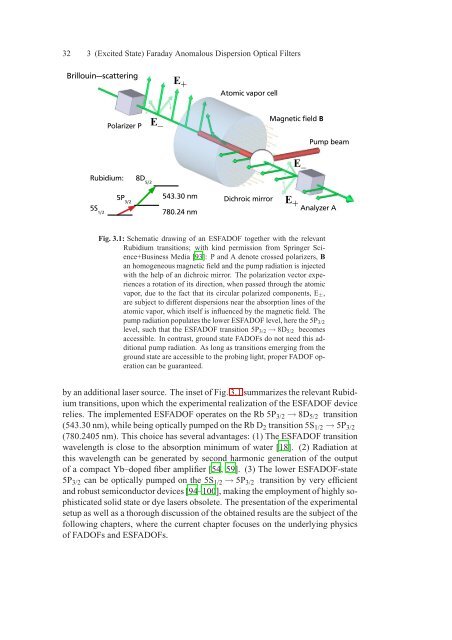Assessment of a Rubidium ESFADOF Edge-Filter as ... - tuprints
Assessment of a Rubidium ESFADOF Edge-Filter as ... - tuprints
Assessment of a Rubidium ESFADOF Edge-Filter as ... - tuprints
You also want an ePaper? Increase the reach of your titles
YUMPU automatically turns print PDFs into web optimized ePapers that Google loves.
32 3 (Excited State) Faraday Anomalous Dispersion Optical <strong>Filter</strong>s<br />
Fig. 3.1: Schematic drawing <strong>of</strong> an <strong>ESFADOF</strong> together with the relevant<br />
<strong>Rubidium</strong> transitions; with kind permission from Springer Science+Business<br />
Media [93]: P and A denote crossed polarizers, B<br />
an homogeneous magnetic field and the pump radiation is injected<br />
with the help <strong>of</strong> an dichroic mirror. The polarization vector experiences<br />
a rotation <strong>of</strong> its direction, when p<strong>as</strong>sed through the atomic<br />
vapor, due to the fact that its circular polarized components, E ± ,<br />
are subject to different dispersions near the absorption lines <strong>of</strong> the<br />
atomic vapor, which itself is influenced by the magnetic field. The<br />
pump radiation populates the lower <strong>ESFADOF</strong> level, here the 5P 3/2<br />
level, such that the <strong>ESFADOF</strong> transition 5P 3/2 → 8D 5/2 becomes<br />
accessible. In contr<strong>as</strong>t, ground state FADOFs do not need this additional<br />
pump radiation. As long <strong>as</strong> transitions emerging from the<br />
ground state are accessible to the probing light, proper FADOF operation<br />
can be guaranteed.<br />
by an additional l<strong>as</strong>er source. The inset <strong>of</strong> Fig. 3.1 summarizes the relevant <strong>Rubidium</strong><br />
transitions, upon which the experimental realization <strong>of</strong> the <strong>ESFADOF</strong> device<br />
relies. The implemented <strong>ESFADOF</strong> operates on the Rb 5P 3/2 → 8D 5/2 transition<br />
(543.30 nm), while being optically pumped on the Rb D 2 transition 5S 1/2 → 5P 3/2<br />
(780.2405 nm). This choice h<strong>as</strong> several advantages: (1) The <strong>ESFADOF</strong> transition<br />
wavelength is close to the absorption minimum <strong>of</strong> water [18]. (2) Radiation at<br />
this wavelength can be generated by second harmonic generation <strong>of</strong> the output<br />
<strong>of</strong> a compact Yb–doped fiber amplifier [54, 59]. (3) The lower <strong>ESFADOF</strong>-state<br />
5P 3/2 can be optically pumped on the 5S 1/2 → 5P 3/2 transition by very efficient<br />
and robust semiconductor devices [94–100], making the employment <strong>of</strong> highly sophisticated<br />
solid state or dye l<strong>as</strong>ers obsolete. The presentation <strong>of</strong> the experimental<br />
setup <strong>as</strong> well <strong>as</strong> a thorough discussion <strong>of</strong> the obtained results are the subject <strong>of</strong> the<br />
following chapters, where the current chapter focuses on the underlying physics<br />
<strong>of</strong> FADOFs and <strong>ESFADOF</strong>s.
















